GDR’s Centre for Art Exhibitions and the ifa
What histories lies behind the Art Collection of the ifa?

“We must first acknowledge our state’s fine artists and their professional association. Without their artistic work, their active support and their collaboration in the preparation and implementation of this endeavour, the work of the Zentrum für Kunstausstellungen would not be possible.”
The extensive collection of graphic art assembled by the GDR Centre for Art Exhibitions (Zentrum für Kunstausstellungen der DDR, short: ZfK) contains close to 10,000 artworks. These include works on paper such as watercolours, ink and hand drawings, lithographs and etchings, small sculptures, portfolios and artist books.
Founded as an independent organisation by the East German Ministry for Culture in 1973, the ZfK’s departments for fine arts, crafts, poster art and stage design made up nearly 80 employees combined. The ZfK’s central task was to organise exhibitions both within the German Democratic Republic (GDR) and abroad. These projects were developed in close collaboration with the GDR’s Verband Bildender Künstler (Association of Visual Artists, VBK) and were exhibited not only in socialist “brother countries” but also in states west of the iron curtain.
Works by seven of the artists presented here – Lea Grundig, HAP Grieshaber, Doris Kahane, Robert Rehfeldt, Herta Günther, Rolf Händler and Angela Hampe – are visible and accessible for the first time in 2024 as reproductions developed through the successive digitalization of the ZfK inventory.
Lea Grundig: Staunch Communist
born 1906 in Dresden, died 1977 on board the MS Völkerfreundschaft (Friendship Among Nations) on the Mediterranean Sea
Lea Grunding, née Langer, was a persecuted communist and staunch antifascist, which helped lead to her status as a favoured artist in the GDR. Like Käthe Kollwitz (1867–1945) she was primarily a printmaker whose imagery was marked by urgency and directness. Born into a Jewish family in Dresden in 1906, Grundig joined the Communist Party of Germany (KPD) in 1926 and became a founding member of the local Dresden group Assoziation Revolutionärer Bildender Künstler Deutschlands (ASSO, Association of Revolutionary Visual Artists Germany) together with her husband Hans Grundig. She fled the Nazis first to Switzerland and then Palestine, where she lived from 1940 to 1948. After learning that her husband Hans had survived internment in the Nazi concentration camps, she returned to Dresden via Prague. That same year, she became a professor at the Hochschule für Bildende Künste Dresden (Dresden University of Fine Arts).
HAP Grieshaber: Cross-Border Creative
born 1909 in Rot an der Rot, died 1981 in Eningen unter Achalm
Helmut “HAP” Andreas Paul Grieshaber was a politically engaged artist who worked primarily from the Achalm region near Reutlingen from the 1950s onwards. Moving between the roles of an art facilitator, teacher, exhibition maker, writer and designer, he soon became a dedicated cultural figure who regularly crossed borders both professional and geographical.
HAP Grieshaber’s trajectory in the arts began with an apprenticeship in typesetting in the early 1920s, during which he also attended the Kunstgewerbeschule in Stuttgart (Stuttgart’s School of Applied Arts). Under Nazi rule, the Reichskulturkammer (Reich Chamber of Culture) threatened to prohibit him from working as a graphic designer and painter. He returned to Germany in 1946 after being held as a prisoner of war by American forces in Belgium.
Mitteilungen, published by the Zentrum für Kunstausstellungen der DDR – Publicity Department, East Berlin 1978.
In 1978 the ZfK showed an extensive exhibition of woodcuts by HAP Grieshaber in the Neue Galerie that were subsequently exhibited at the Kunsthalle Rostock and the Staatliche Kunstsammlungen Dresden. The ZfK published a special issue of its informational brochure, Mitteilungen (Communications), to mark the occasion.
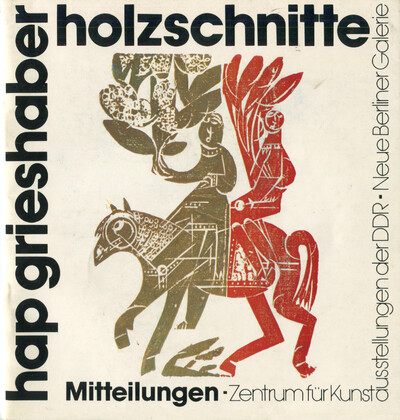
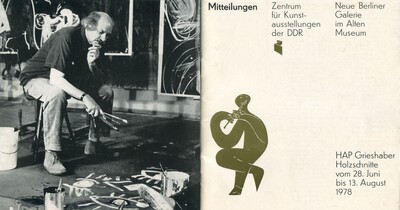
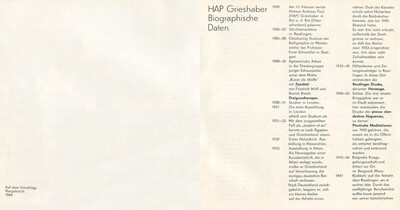
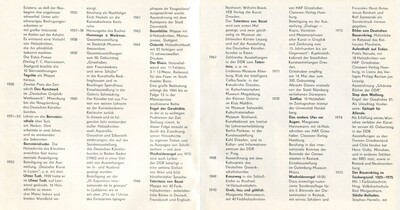
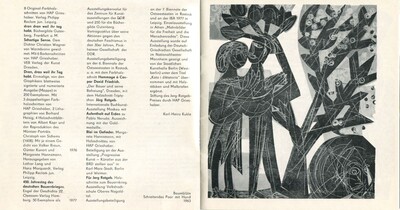
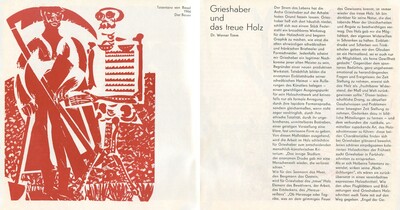
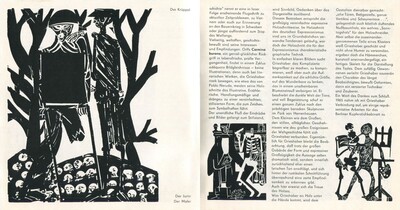

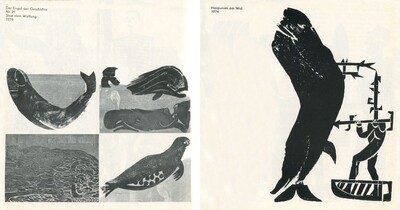
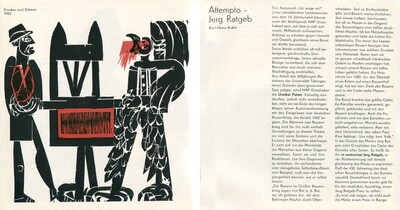



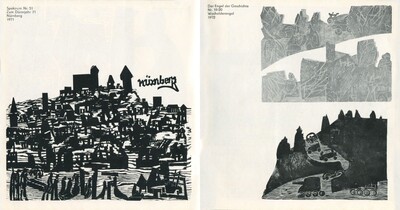


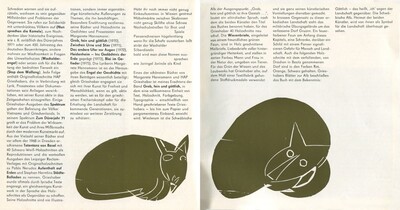

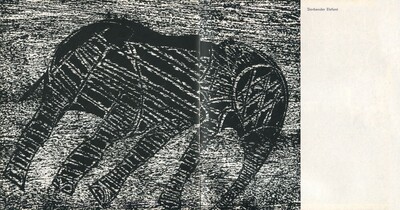
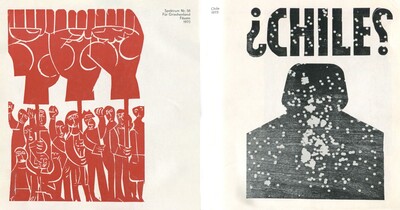
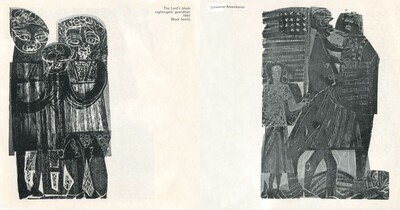
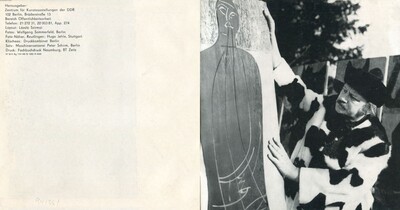
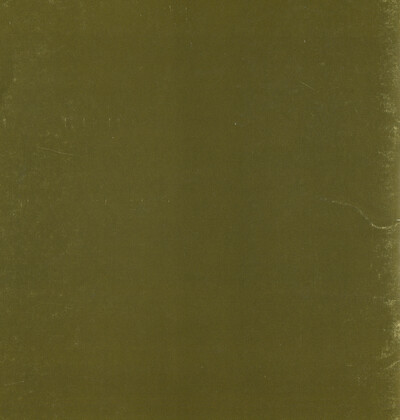
Doris Kahane: Contemporary and Companion
born 1920 Berlin, died 1976 East-Berlin
“Doris Kahane has been a staple of artistic life in the German Democratic Republic and its capital of Berlin for many years. Her fundamental worldview, her experiences in the struggle against fascism from early adolescence, her knowledge of many countries, her sensitive artistic judgment, and the very personal, immediate sensibility of her images make her an artist whose work one looks for in exhibitions, a friendly source of advice for many a young artist, and a respected interlocutor in many discussions of the Artists’ Association.”[1]
Thus Peter Feist praised Doris Kahane in a thin volume published by the Zentrum für Kunstausstellungen der DDR for an exhibition of Kahane’s work that opened in Vienna in 1973.
Helena Scigala: Woodcutter
born 1921 in Batow (present-day Batowo, Poland), died 1998 in Berlin
Helena Scigala, born 1965 in Polish Farther Pomerania, is listed in a book on young visual artists in the GDR as one of 25 people who, alongside painters like Walter Womacka or sculptors like Werner Stötzer, most saliently shaped the post-war art of East Germany.[1] This was the era in which Scigala, then living in Berlin, experienced her most fertile period as a graphic artist. Besides numerous solo exhibitions, Scigala was the only woman chosen (alongside 14 male colleagues) to represent the work of graphic artists in the GDR at the international competitive exhibition IBA Leipzig 1965.
Robert Rehfeldt: Mail Artist, Painter and Graphic Designer
born 1931 in Stargard in Pommern (present-day Stargard, Poland), died 1993 in Berlin
DEINE IDEE
HILFT MEINER
IDEE, UNSERE IDEEN
HELFEN ANDEREN IDEEN!
(YOUR IDEA
HELPS MY
IDEA, OUR IDEAS
HELP OTHER IDEAS!)
Robert Rehfeldt
Herta Günther: Delicate Outsiders
born 1934 in Dresden, died 2018 in Dresden
According to Lothar Lang, Herta Günther “preferred depicting the life of the people, namely its cheerful and leisurely side: views into storefront windows or of urbanites milling about on boulevards and chatting in cafes.”[1] Günther’s work is thus described in a thin volume about the artist from 1983, part of a magazine series published by Verlag der Kunst Dresden, a state-owned art book publisher in the German Democratic Republic (GDR). In the same booklet, Ingrid Wenzkat uses the words “sensitive” and “sfumato” to characterize her images. She emphasizes the Günther’s frequent “balancing acts between colours” and points out the “deliberately candied and lascivious” aspects of her work, which may stem from a penchant for circus rings, theatres, and garden cafés, as well as portraits of women.[2]
Horst Bartnig: Complex Calculations
born 1936 in Militsch (present-day Milicz, Poland)
Horst Bartnig, painter and computer graphic designer in Berlin, belongs to the vibrant and internationally networked scene of concrete art. Born 1936 in Milicz in Silesia, he studied stage design starting in 1954 at the Kunstgewerbeschule Magdeburg. He worked professionally as painter of sets first in Weimar and later in Berlin. During this period, he occasionally accompanied the Deutsches Theater on its foreign tours. It was on one of these occasions that he first met, in 1987 in Zurich, the artists Richard Paul Lohse and Max Bill. In 1984, Bartnig had already won the prize at the 7th Norwegian Biennale of Graphic Art in Frederikstad. He went on to win the Will-Grohmann Prize of the Akademie der Künste Berlin in 1993 and the Hannah Höch Prize in 2001.
Renate Göritz: modern-mystical fantasies
*1938 in Königsberg, Prussia (today: Kaliningrad, Russia), †2021 in Berlin
In one of her countless poetic texts about herself as painter, graphic designer, and object artist, Renate Göritz described her work as a kind of "wandering through dream landscapes". Born in 1938 in East Prussia, Göritz maintained lifelong – despite or perhaps rather as a result of the nightmarish experiences of war and exile that she lived through as a young child – a deeply personal, fantastic imagination, just brimming over with images. Having fled from Königsberg over Denmark to Schwerin in East Germany, the young girl early on, indeed almost automatically, as she recalls, began to "draw, write, scratch, scribble, hatch and paint". This may have been a kind of hopechest from her mother, who in since 1958 – after long experience of penury and hunger – astonishingly permitted her daughterto study the penniless trade of art at the Kunsthochschule (Academy of Art) Weissensee. Here in East Berlin, Göritz first came into contact with art from around the world, but especially with the art of the 1920s, such as Expressionism.
Rolf Händler: “What are Languages For?”
born 1938 in Halle an der Saale, died 2021 in Berlin
Rolf Händler’s paintings and prints have earned a firm place in the East German art scene. The expansion of possibilities for artistic expression during what was likely the most productive phase of this country’s thirty-year art history has once more brought up the question of the term “art”. What is art? Even artists ask this question when it comes to its various styles. I think the question can be replaced by another. What are languages for? They are indispensable for communication. And art is a form of communication about things that cannot be expressed in words, but are no less important than our daily bread. A means of communication about things that would remain unspoken forever if it weren’t for people like Rolf Händler, who by virtue of a talent, an ability only they possess, give a visual, sensory shape to sensations and feelings, ideas and impressions.
Erika Stürmer-Alex: Gestural and Abstract Painting
born 1938 in Wriezen, Brandenburg
Stürmer-Alex blasted the hierarchies of medium and genre even during GDR times, contradicting the prevalent cultural policies and often enough leaving her viewers baffled. The “Wild Old Woman” thus encouraged an entire younger generation to give shape to an expressive, emotional art that ignored all the dogmas of Socialist Realism. She asserted herself with color-field painting, with gestural and abstract painting, as well as with her scurrilous-humorous sculptures, in which we may recognize a sensual and at the same time deeply funny affinity of spirits with the colorful, feminist-chick sculptures of the French-Swiss artist Niki de Saint Phalle.
Hans Ticha: Provocation and Satire
born 1940 in Bodenbach (present-day Podmokly, Czechia)
Whatever Hans Ticha painted, he captured its essence. Born 1940, he studied with Kurt Robbel and Arno Mohr at the Kunsthochschule Berlin-Weissensee. He developed a style that is provocative and ironic, figurative and yet abstracted as into a template. Everything in the image is mercilessly stylized, so up-close that an alienating effect creeps in. Ticha was one of the GDR’s most singular Pop-Art satirists, someone who packed his pictures full of keen insights into his time. The Stasi always held him in suspicion: he lived dangerously. Only friends ever saw his acerbic art; and none of them betrayed him.
Angela Hampel: Expressive and Gestural
born 1956 in Räckelwit, Sachsen
The ZfK collection houses three lithographs from Angela Hampel’s Penthesilea cycle, completed in1985-86. Most notable in this complex of works about mythological female figures are several large-format, expressive paintings. Two drawings show the battle of the sexes fought out between lovers. Not only are the genders of the figures unclear, their gestures also oscillate between violent and loving, alternately grasping and fending off. These works reference Christa Wolf’s book “Kassandra”, which had appeared in 1983. Reading the play by Heinrich von Kleist had been “revelatory” for Hampel. “It offered something to identify with as a woman, as a female artist. It was encouraging and validating.”[1]
The page “Artists from the Collection of the Zentrum für Kunstausstellungen der DDR” was made possible through a project in cooperation with the Wüstenrot Stiftung. Edited by: Susanne Weiß (Curator of the Art Collection, ifa) in collaboration with Tina Weingardt (Collection Manager, ifa) and Paulinus Burger (research assistant, ifa). Proof-reading: Karolin Nedelmann. Translation: Moira Barrett and Darrell Willkins.

More about the ZfK: